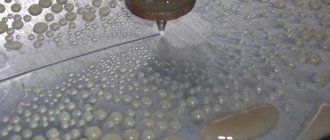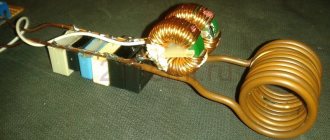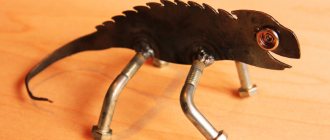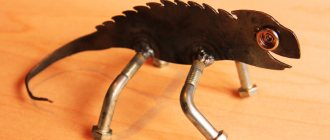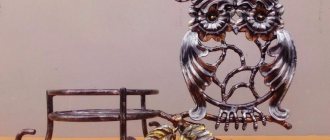In a home workshop or small business producing products from thin sheet metal, sheet metal shears, more simply - a guillotine - will never be superfluous. The driven version can be installed, for example, in a garage, and a manual guillotine will not take up much space at all. If you have a fairly large number of manufacturing options (in drawings, videos or descriptions), as well as some adapted components from some decommissioned equipment, making homemade metal shears is an accessible reality.
Homemade hand guillotine
Trying to make a manual guillotine with your own hands
A manual guillotine for cutting metal with your own hands is not such an unattainable goal. You must be able to work with welding and some plumbing tools.
Metalworking machines are expensive and complex equipment that not every workshop, let alone an individual, is able to buy. But many of the machines can be made independently. For example, a manual guillotine for cutting metal with your own hands is not such an unattainable goal. All you need is the ability to work with welding and some plumbing tools.
Naturally, it is impossible to do without financial investments. For example, there is no way to make knives yourself. This is a complex factory-produced part that requires special steel and machines to process it. But you can easily buy guillotine knives on the market, on the Internet or in specialized stores.
If they offer guillotine knives that have worked for several years at a large factory, you can buy them, but be mindful of what kind of metal you are going to cut on your machine. If roofing steel or corrugated sheeting, then buy without fear. After sharpening, they will cope with such a task without difficulty. But for cutting reinforcement, corners or sheets thicker than 1.5 mm, new knives will be required, without “work experience”. They are relatively inexpensive, and you can choose them by length, sharpening angle and height.
A knife made from a spring will never have the capabilities of a factory one.
Many craftsmen use various metal machine parts for knives, for example springs made of steel of sufficient hardness. But such scissors will be useful only for rough cutting of thin-sheet steel - achieving ideal straightness of the blade without lateral deviations at home is difficult, almost impossible. It is better to stop at buying factory-made knives. The peculiarities of the interaction between the knife and the steel sheet require special strength of the cutting edge.
Main parts of guillotine shears
A do-it-yourself metal guillotine consists of the following main parts:
- beds;
- desktop;
- vertical guides;
- gear racks;
- gearbox;
- lever (pedal);
- rulers.
Desktop
The base is a metal table made of a plate with a thickness of at least 10 mm. It is not advisable to use a wooden shield, even of great thickness. Wood is springy and can warp due to changes in humidity, and for cutting metal it is important that the machine is in a strictly defined position.
Two guide tubes of round or rectangular cross-section, or rods, along which the upper beam with the knife will move, are welded to the plate. If a tube is used, it must be thick-walled.
To prevent the tube from being deformed during welding, a smaller diameter bolt or steel rod should be installed inside.
The guides must be strictly parallel to each other and perpendicular to the plane of the table.
The horizontal beam to which the upper knife will be attached must move along the guides without resistance, but also without play. This will be ensured by bushings welded to the ends or mounted into the beam, into which the guides are inserted with minimal clearance. The inside of the bushing and the surfaces of the guides are ground and lubricated.
Drive unit
The vertical force is transmitted to the beam by means of gear racks welded at the ends.
To ensure uniform movement of the beam, slats must be on both sides. The force on the rack is transmitted from the gear, connected directly to the lever mechanism, or to the reduction gear. By using different lever ratios and gear diameters, the desired force on the knife can be achieved with minimal impact on the drive. To ensure that both drive gears rotate evenly, they are connected by a shaft that runs under the table. A pedal can be used instead of a driving lever. To prevent the beam from lowering on its own, upper position clamps or return springs are installed.
Knives
Knives, as already mentioned, are industrially manufactured. They are sharpened in the factory at a certain angle, which must be maintained when re-sharpening. They are secured to the frame and beam with bolts, holes for which are provided during manufacture.
The gap between the knives is adjustable within 0.1-0.7 mm, depending on the thickness of the sheet.
On factory guillotines, the inclination of the upper knife from the vertical is adjustable and ranges from 1-30. It is impossible to achieve such precision at home, so the knife is installed strictly vertically. With small thicknesses of the sheet being processed, a slight increase in the required force is almost imperceptible.
Features of work
Those devices that are designed for cutting metals, mainly sheet type due to a chopping motion, are called guillotines.
In most cases, metal cutting is carried out at industrial enterprises; special-purpose equipment is used for this.
The need for cutting sheet metal may also arise for home craftsmen who are accustomed to doing all the housework with their own hands.
In this case, special manual guillotine metal shears are used for cutting sheet metal, which can be seen in the photo below.
In addition, you can assemble a special unit for cutting metal. This simplified device consists of a sharpened blade, which is driven by a lever that is firmly attached to its base.
In order to cut metal using such a unit, it must be laid on the frame and the blade must be set in motion with a smooth movement. If you assemble it according to all the rules, you can cut metal with great precision.
Manual guillotines, together with metal shears, are used in their work by roofers, who use these tools to cut the necessary blanks from the roofing material.
The operation of hand-held devices for cutting metal is somewhat similar to devices that are used in the printing industry for cutting paper and cardboard.
Such units are compact in size and do not require electrical energy to operate.
It should be noted that repair of guillotine shears, if necessary, can be carried out on your own.
Automatic guillotines, which are mainly used in industrial enterprises, have a more complex design.
The scheme of their operation is vaguely reminiscent of the functioning of manual units, but the functionality is several times greater.
Making a manual guillotine in the video below.
Guillotines with hydraulic and electric drives, as well as crank devices, can be distinguished. All these units differ from each other in design, and also have both advantages and disadvantages.
Materials and tools Guillotine cutter
I now have the much desired guillotine cutter. I wanted one from Martha Stewart, but I couldn’t find it in stock anywhere. And if there is, it’s with an exorbitant price. This one is good too. Moreover, I am already familiar with this company. Quite compact and functional.
The paper size is 13 inches or 33 by 35 cm.
Markings in centimeters on one side.
On the other hand, in inches.
There are markings on the site for commonly used formats of postcards and works.
The clamping bar holds the paper very comfortably and firmly and serves as protection for the fingers.
The handle of a knife, the guillotine itself (a terrible name, for some reason France immediately comes to mind).
Ruler on the lower knife, which is not movable.
Pull-out bars with rulers, inches and cm, which increase the working area.
This is the bottom. It has non-slip feet, and a key for adjusting the stroke of the knife, attached to a special socket.
Here on the side there is a magnet that is not visible, it is inside, and when you lower the knife it clicks, securing the knife. And no matter how the board is turned over, the knife holds on, does not open or dangle.
This is the articulation unit of the cutter itself, which is adjusted with a key. How convenient it is to cut. Smooth ride.
We measure on the ruler as much as we need.
Lower the cutter. Everything was cut effortlessly and evenly, evenly!
I cut a stack like this in about fifteen minutes. Takes 160 g/m paper, four sheets. Well, a simple notebook, in small piles. Well, just don’t overload it with thickness. Film and cardboard are also possible. It is written in the instructions that there is a lifetime guarantee, as I understand it, the knives themselves appear to be self-sharpening. This is nice, we'll test it with time. No, I wrote it wrong, the stack of sheets that is in the photo and another one that has already become notebooks.
I am pleased with the purchase, especially the desired one. She described the cutter in such detail, maybe it will be useful for someone, for example, it would be very useful for me. It’s convenient to use, doesn’t take up much space, and looks very nice. And you can use it from the age of 14, as it says on the packaging and in the instructions. Thanks for your attention and viewing! I am glad to everyone, I wish you health and peace!
Olenka, congratulations on your purchase, I will look forward to new works.
Elechka, thank you! I already have some work, I made four notebooks. On springs. I'm mastering binder.
What a necessary item.
Tanya, thank you for your feedback. The thing is necessary, I have wanted it for a long time, it is needed on an equal basis with a scoring board. It makes the job very easy, the edges are smooth and even.
LLC What a valuable acquisition. Great!
Yes, Lilechka! Really good purchase, so far I'm happy with it!
Wow, what a cool car! Olechka, congratulations on such a necessary and wonderful acquisition!
Thank you, Lyubushka! I’m thinking about asking Dedik Morozik to wear slippers for New Year’s Eve or Christmas. Well, probably something simpler, some consumables.
Olenka, congratulations - a wonderful purchase. I remember the Soviet photo cutters)))
Thank you, Elena Ivanovna! Yes, we had one, but it was put somewhere, or thrown away, or given away, I don’t even know. I searched and couldn't find it. It would have been useful, especially since it was big. Well, science will, don’t throw it away, think about it.
Oh, Olenka, this is a classic - something is lying there, lying there unnecessarily. It's worth throwing it away - you'll need it right away
Olya, happy new thing for you!
Marina, thank you! I love tools, all kinds of gadgets!
Wow. I regret that I wasted my time and didn’t buy a good big cutter. Now I'm looking at this one too
Olya, thanks for the story! I also heard about guillotines that they don’t need to be sharpened.
Irina, this gnome is undoubtedly very useful and is constantly at work, I wonder how I managed before. He has his own whims, well, you can adapt to them, for example, he always wants to bend thin, limp paper in one place, so I lower the cutter in two movements, lift it a little and let the paper straighten, well, this is due to the paper, to its quality . It cuts our beautiful and thick scrap paper perfectly, it can cut several sheets at once. My conclusion, the board and cutter are very good purchases, needed. Let me boast, I started using a binder, time after time the spring turns out smoother. I made 16 notebooks, I spend more time decorating and thinking about the decor than making the notebook. Gnome helpers! You, Irina, need such an assistant, especially since you have students!
The work of the simplest scissors for working with metal
The principle of cutting with guillotine (sheet) shears is that the knife beam of the device, to which the movable part of the tool is attached, must have an angle of 1.5...3° along the working end, due to which metal cutting occurs non-simultaneously across the entire width. This reduces the cutting force, but requires a technique that would compensate for the shear of sheet metal (tin, pressed cardboard, etc.) during cutting. Likewise, a secure clamp will be required.
The main components of the saber guillotine
To drive a homemade guillotine, you can use an electric motor of limited power, because the energy intensity of the process is low. However, according to the results of calculating the greatest cutting force, a manual drive, for example, a lever type, is usually sufficient (in home-made devices this is often offered). You will also need reliable guidance of the moving parts during the cutting process, as well as a rigid supporting surface of the bed. In this case, the parts of the homemade guillotine and the product itself will not change elastically.
In most cases, the drawings indicate the limits of the thickness and width of sheet metal or sheet metal for which the device is designed. If the general process of producing sheet shears with your own hands is carried out on your own, then the design begins with clarifying the power parameters of cutting and choosing a mechanism diagram.
The starting data for choosing a design are:
- material with which operations will be performed;
- maximum sheet dimensions for thickness, length and width;
- division accuracy;
- maximum dimensions and dimensions of scissors;
- type of drive.
Guillotine device
The picture explains everything well:
Since metal is cut using a guillotine, the main requirement for the design is stability and strength.
bed
It is clear that it is unlikely to be possible to select cast iron racks. Unless to carry out partial dismantling of decommissioned industrial equipment/equipment. But does everyone have this opportunity? For arranging supports for a household guillotine, a channel, a large cross-section pipe, or a large angle are quite suitable. Here you need to know what samples you plan to work with - thickness, type of metal (aluminum, steel).
Tabletop
In addition to strength, it must have strict geometry. An integral part of the guillotine is a clamping bar that securely fixes the sheet (or bundle) on the tabletop before cutting. The slightest distortion can lead to uneven edges, the appearance of burrs, and the like. For the table surface you need to choose thick sheet iron (at least 8 mm).
All other options - chipboard, OSV, FC, getinax and so on - are not suitable. There are recommendations that indicate exactly these materials. But it does not specify how long such a table will last, especially if the guillotine is used frequently. In addition, a tabletop made of thick metal adds stability to the entire structure, which cannot be said about plywood or other light-weight samples.
Its dimensions are chosen arbitrarily, based on the dimensions of the sheets that are supposed to be cut. That is, everyone designs a guillotine to suit their needs.
Both the upper and lower ones should only be made of tool steel, and with proper sharpening. These are probably the only components that will have to be ordered, since you definitely won’t be able to make them yourself. For example, through friends at a factory, in a specialized workshop.
Structural elements
A manual guillotine for cutting metal has the following components:
- Bed;
- Desktop;
- Knife;
- Vertical guides;
- Toothed racks (drive);
- Gearbox;
- Lever arm;
- Ruler.
Desktop Features
The working surface is a metal plate no less than 1 cm thick. It is not recommended to use wood for this, even if it is a very thick panel, as it will spring back and become deformed. It is important for the equipment to remain in one unchanged position.
2 guides are installed on the plate (round or profile pipe). The upper beam with the knife will move along them. It is advisable to choose thick-walled material. In this case, the guides must be placed in such a way that they are exactly parallel to each other and in a perpendicular plane to the table.
The knife will subsequently be attached to the horizontal beam. The beam must be allowed to move freely along the guides. In this case, there should not be excess resistance, but there should also be no backlash. This can be achieved by welding bushings along the edges of the beam, which will be inserted into the guides with a small gap. The inner surfaces of the bushings should be lubricated.
Drive mechanism
The vertical movement of the beam can be ensured using gear racks by welding them at its ends. By placing the slats on both sides, you can achieve uniform movement. The forces on the rack will be transmitted from the gears connected to the lever mechanism. By considering different leverage ratios and gear diameters, it is possible to achieve the required force applied by the knife. In this case, the impact on the drive will be minimal.
In order to ensure uniform rotation of the gears, they must be connected by a common shaft, which can be placed under the working plane. An analogue of the design can be a pedal drive. To prevent spontaneous lowering of the beam, it is recommended to install an upper position lock or a return spring.
What can you cut with a homemade guillotine?
Homemade guillotine shears can function as full-fledged factory equipment. This belief has been proven by many home craftsmen who have created a similar machine at home.
The most common modifications are devices with direct knife movement and with a change in angle. In the first case, the knife moves in a vertical position and ensures precise cutting of metal products. The second modification is capable of cutting not only sheet metal, but also reinforcement bars and large metal corners.
A homemade guillotine has some limitations in size. This is explained simply. Industrial equipment has various types of drive (hydraulic, pneumatic, electric). In a homemade device, the drive looks like a mechanical lever or pedal mechanism. The force applied by the master directly affects the thickness of the material being cut.
A guillotine for cutting metal, assembled in-house, can be equipped with an electromechanical drive. It is quite difficult to install hydraulics or pneumatics on the drive.
A homemade guillotine can cut:
- Sheet steel – black and galvanized with a thickness of up to 1.5 millimeters;
- Stainless steel up to 0.6 millimeters;
- Aluminum;
- Plastic;
- Cardboard.
When designing equipment, it is advisable to take into account the material planned for cutting.
Types of machines
Depending on the metal planned for processing, its thickness, and frequency of use of the machine, different types of devices can be used. In one case, manual installation is suitable, but in another, only an electromechanical or even hydraulic machine can help. On the modern market you can find a huge number of different models with additional functions. The price is also varied. However, there are basic types of guillotines that have become widespread.
The manual model is the simplest device. Such equipment can easily cope with thin sheet metal, plastic, plexiglass, thick cardboard and rubber. It operates without power from the electrical network, but using a lever-spring mechanism. The big advantage is that there is no need for additional communications.
The hydraulic machine is used mainly in large and medium-sized production. A distinctive feature is the high accuracy of cutting and cutting of metal blanks of various thicknesses. A guillotine machine ensures cutting accuracy due to the mass of structural elements.
Pneumatic equipment also provides excellent cutting accuracy. The principle of operation is similar to the previous version with the only difference being that a compressed air system is used.
Mechanical shears have proven their reliability and accuracy in every enterprise. Consumes a minimal amount of electricity. The movement is created by an electric motor and transmitted through the shaft directly to the working parts.
The electromechanical device is characterized by the greatest productivity, as it has high efficiency, high cutting accuracy and low energy consumption.
Homemade guillotine for cutting metal
- Home / Services / Cutting
Welded housing supports KP-A11
Body-welded CP supports are designed for fastening steel process pipelines with different outer diameters and for various purposes.
Metal caisson for well
A caisson is a device made of plastic or metal that is impermeable to water.
Pontoons
A pontoon is a watercraft that, having positive buoyancy, serves to maintain afloat and move various cargoes. Pontoons provide support for floating bridges, crossings and various structures.
The metal is produced in the form of castings, forgings and rolled products. We work with rentals. Rolled products need to be cut for use in structures and for further processing. Metal cutting is a procurement operation, usually more labor-intensive and expensive than the actual assembly or final processing.
We use a guillotine . Cutting (cutting) on a guillotine, on the one hand, has high speed and low cost, on the other hand, there are some restrictions. For example, a guillotine cuts only straight cuts and the entire length of the workpiece. And the most unpleasant thing is that the parts (pieces of sheet) from under the guillotine are deformed, taking on the shape of a screw instead of the desired plane. That's why we use a guillotine to cut sheets up to 6 mm thick.
For critical or thick sheets, plasma cutting . We cut sheets up to 30 mm from any materials. It has limitations in thickness, but it cuts stainless steel, copper, and aluminum.
For workpieces thicker than 30 mm, gas cutting (oxygen cutting) is used using an appropriate post. But only black steel can be cut in this way. As for long products, we use mechanical saws , which give an accurate and even cut. However, sawing thin-walled steel with a saw is problematic.
Hydraulic units – guillotines of professionals!
The most powerful are hydraulic guillotines; they also have the highest characteristics in terms of cutting length and material thickness, which reach up to 8 or more meters and up to 60 mm, respectively. Such units are divided into two types, depending on the method of blade feeding:
- direct vertical type, in which the frame with the working blade moves up and down along guides, carrying out cutting;
- blade feed with a rotating beam - in this design, the working blade, mounted on the frame, rotates around two attachment points located on the side walls. The movements of the blade resemble those of a bulldozer bucket.
The advantage of the second type is the much smaller dimensions of the entire structure, ease of maintenance and low cost. The main advantage of direct blade feeding is the ability to adjust the angle of the blade, since for optimal cutting of different sheets it is necessary to set an angle from 0.5° to 4°, thanks to which such units cope with their task perfectly, whereas when feeding a blade with a rotary beam When cutting metal of great strength or thickness, the quality of the cut will be noticeably lower.
For hydraulic guillotines, it is important to have a durable, heavy body, the rigidity of which ensures high cutting accuracy. Knives for units usually consist of meter-long modules, which are made of high-strength steel. There are knives for cutting ordinary metals and especially durable ones. As a rule, one knife can have 2-4 working edges. By periodically changing sides, we significantly extend the service life of the entire unit.
Reciprocating scissors
A type of metal shears that works on the guillotine principle is a machine in which the upper knife moves not along guides, but in an arc around a rotary axis on which one of the ends of the knife is fixed.
Its design is reminiscent of a photo cutter, which was once used to crop photographs. The second end of the knife is connected directly to the lever handle. The knife acts on the sheet of metal not simultaneously throughout the entire cut, but gradually, which allows you to cut metal of considerable thickness without too much effort. By adjusting the gap between the knives, you can achieve fairly decent results in terms of cutting accuracy and the absence of lateral deformations in the working area.
As a rule, the upper knife is placed on a bearing and frictional forces do not increase the operator effort required for cutting.
Other features of laser cutting
One of the so-called “disadvantages” of laser cutting is its low availability. Laser cutting of metal with your own hands, taking place in some small garage, is a very controversial opportunity for a simple buyer who does not have a large amount of money to purchase laser equipment.
Based on the high cost factor, only if such a step is sufficiently justified should laser metal cutting (equipment) be chosen. Its price, however, although high, there are many enterprises and individuals who have the financial means to purchase such equipment.
Cost of cutting services
When the need arises to use a guillotine, you can make it yourself or purchase a ready-made one.
The simplest version of a ready-made cutter is a stationary manual guillotine, costing approximately ten thousand rubles.
However, its disadvantage is that a manual machine can cut sheet metal up to 7 mm in thickness. Therefore, it is more often used for cutting aluminum.
Profile aluminum sheets have been the most popular material in construction lately; its price is not high, it is easy to use, but often requires cutting.
Manufacturers whose hand guillotines are of high quality include Stalex and Say-Mak. The Far Eastern company Papsher produces scissors for private use; their range includes not only manual, but also electromechanical guillotine. The price of devices on the Russian market is affordable for the average buyer.
Unfortunately, the electromechanical guillotine, which is used not in production, but in home construction, although it has a maximum pressing force of 1400 Joules, the electromechanical guillotine will not be able to cut steel.
Cutting steel sheets with your own hands is only possible using the hydraulic type.
For metal cutting services, you can contact any metalworking enterprise. This is a relatively cheap cutting method, in which the cut areas must be polished with a special grinding disc.
If you still decide to buy a guillotine rather than seek services, we recommend purchasing an imported machine due to its higher quality.
For example, the Bosh company offers high-quality knives, the functionality of which is quite large, their price is also high, but at the same time their service life exceeds the service life of analogues by 4-7 times.
Another important property is that the manufacturer creates diamond-coated knives, which allows the cutter not to become dull for a long time (about ten cuts).
